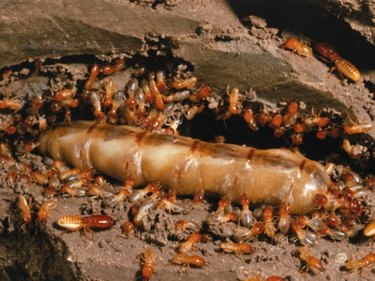
Wood is a sturdy material -- that's why we build our homes from it. Nonetheless, a surprising number of organisms can digest wood and tree bark. Many of these organisms play an important role in nature, because they ensure that nutrients stored in wood from dead and decaying trees are recycled through the ecosystem. From a human perspective, however, these organisms often become a nuisance.
Bacteria & Fungi
Video of the Day
The most important wood-eating organisms in nature are bacteria and fungi, because all other organisms that eat wood depend on bacteria to break it down for them. Species of fungi like those that cause brown, white and soft rot are all decomposers, with the ability to break wood down and consume it for their own nutrition. In nature, these bacteria and fungi play an essential role, because without them dead wood would accumulate. For humans, however, these fungi can sometimes be a problem. The fungi that cause brown rot, for instance, are a common cause of softwood decay in buildings.
Video of the Day
Insects
Around the world, termites consume thousands of tons of wood and woody debris each year. Other insects such as bark beetles and wood borers also possess the remarkable ability to digest wood and bark. Like termites, they owe this ability to microbes in their gut. These tiny helpers secrete enzymes to break down the wood for their host, supplying their host with needed nutrients while earning a free meal and favorable environment in exchange.
Mammals
A surprising number of mammalian herbivores eat wood sometimes or frequently. Beavers are perhaps the most familiar example. Many ruminants like deer and moose, however, subsist partly on twigs and other woody matter, and even the humble rabbit will sometimes munch on bark in the wintertime. All of these animals digest woody matter with the aid of bacteria in their digestive systems, just like the termites. Ruminants with their multi-chambered stomachs house a wealth of symbiotic bacteria in the first chamber of their stomach, the rumen. Other animals like beavers and rabbits eat some of their own feces, thereby ensuring the difficult-to-digest material passes through their digestive system more than once so their microbes have a more prolonged opportunity to break it down.
Other Animals
A variety of other animals also eat wood as well. Two especially notorious examples are shipworms and gribbles. Shipworms are saltwater clams infamous for their ability to bore into ship hulls. Like other wood-eating animals, they too have symbiotic bacteria that tackle the tough job of disassembling their woody meal. Gribbles are marine crustaceans with a peculiar appetite for bacteria growing in submerged wood. As they graze on the bacteria, they open widening burrows through the wood, eventually causing docks and other structures to collapse.